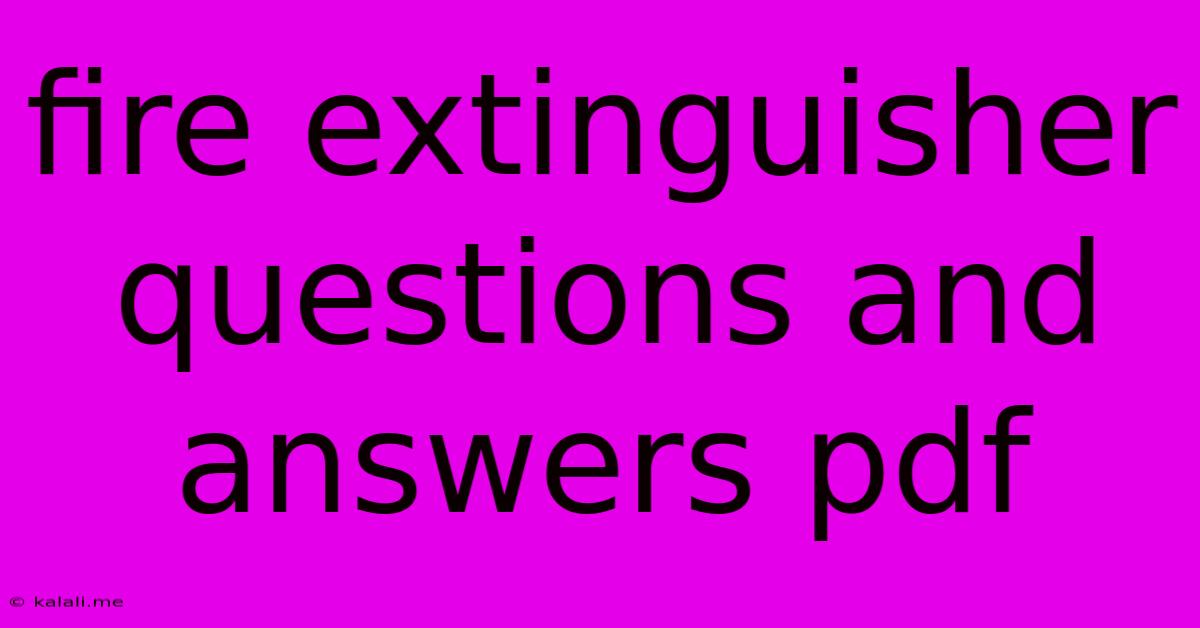Fire Extinguisher Questions And Answers Pdf
Kalali
Jun 16, 2025 · 3 min read

Table of Contents
Fire Extinguisher Questions and Answers: A Comprehensive Guide
Meta Description: This comprehensive guide answers frequently asked questions about fire extinguishers, covering types, usage, maintenance, and safety. Learn everything you need to know about fire extinguisher safety and preparedness.
Fire safety is paramount, and understanding how to use a fire extinguisher is a crucial part of that. This guide provides answers to common questions about fire extinguishers, helping you feel confident and prepared in the event of a fire. Whether you're a homeowner, business owner, or simply interested in fire safety, this information is invaluable.
What are the different types of fire extinguishers?
Fire extinguishers are classified according to the type of fire they are designed to extinguish. Knowing the class of fire is critical for selecting the appropriate extinguisher. The most common classes are:
- Class A: Suitable for fires involving ordinary combustible materials like wood, paper, cloth, and trash. Look for extinguishers with a letter 'A' in their rating.
- Class B: Effective against flammable liquids like gasoline, oil, grease, and paint. These extinguishers often bear a letter 'B' in their rating.
- Class C: Used for electrical fires involving energized electrical equipment. Look for extinguishers with a letter 'C' in their rating.
- Class D: Specifically designed for combustible metals such as magnesium, titanium, and sodium. These are less common in residential settings.
- Class K: Intended for cooking oil and grease fires commonly found in commercial kitchens. These are essential for restaurants and food service establishments.
Many extinguishers are multi-purpose, combining different classes (e.g., ABC). Check the label carefully to understand its capabilities.
How do I use a fire extinguisher? (PASS Method)
Remember the PASS method:
- Pull the pin: Remove the safety pin from the extinguisher.
- Aim at the base of the fire: Direct the nozzle towards the bottom of the flames.
- Squeeze the lever: Squeeze or press the handle to discharge the extinguishing agent.
- Sweep from side to side: Move the nozzle back and forth to cover the entire burning area.
How often should I inspect my fire extinguisher?
Regular inspection is vital for ensuring your fire extinguisher is in working order. You should visually inspect your extinguisher monthly, checking for:
- Pressure gauge: Make sure the pressure gauge is within the acceptable range (indicated on the gauge itself).
- Nozzle: Ensure the nozzle is not clogged or damaged.
- Hose: Check the hose for any kinks, cracks, or damage.
- Physical condition: Look for any dents, rust, or signs of damage to the cylinder.
A professional inspection and servicing should be conducted annually by a qualified technician. This ensures proper functionality and compliance with safety standards.
What are the signs that my fire extinguisher needs servicing?
Beyond the monthly visual checks, consider professional servicing if you notice:
- Low pressure: The pressure gauge indicates low pressure.
- Visible damage: There are dents, rust, or other visible signs of damage.
- Discharge problems: The extinguisher fails to discharge properly.
- Expired expiry date: The extinguisher has exceeded its manufacturer's recommended service life.
Regular servicing is crucial for maintaining the effectiveness of your fire extinguisher and ensuring your safety.
What should I do after using a fire extinguisher?
After using a fire extinguisher:
- Evacuate the area immediately: Ensure everyone has safely exited the building.
- Call emergency services: Contact your local fire department or emergency services.
- Report the incident: Inform your landlord or property manager, if applicable.
- Get the extinguisher serviced: Have the used fire extinguisher professionally inspected and recharged or replaced.
This guide provides a basic understanding of fire extinguishers. Remember, proper training and familiarity with your specific extinguisher model are crucial for effective fire safety. Always refer to the manufacturer's instructions for detailed information. Your safety depends on it.
Latest Posts
Latest Posts
-
How To Create Clickable Image In Html
Jun 16, 2025
-
What Are The Factors Of 121
Jun 16, 2025
-
What Is A Theme Of The Passage
Jun 16, 2025
-
A Company That Provides Access To The Internet
Jun 16, 2025
-
Which Word Is Closest In Meaning To The Underlined Word
Jun 16, 2025
Related Post
Thank you for visiting our website which covers about Fire Extinguisher Questions And Answers Pdf . We hope the information provided has been useful to you. Feel free to contact us if you have any questions or need further assistance. See you next time and don't miss to bookmark.